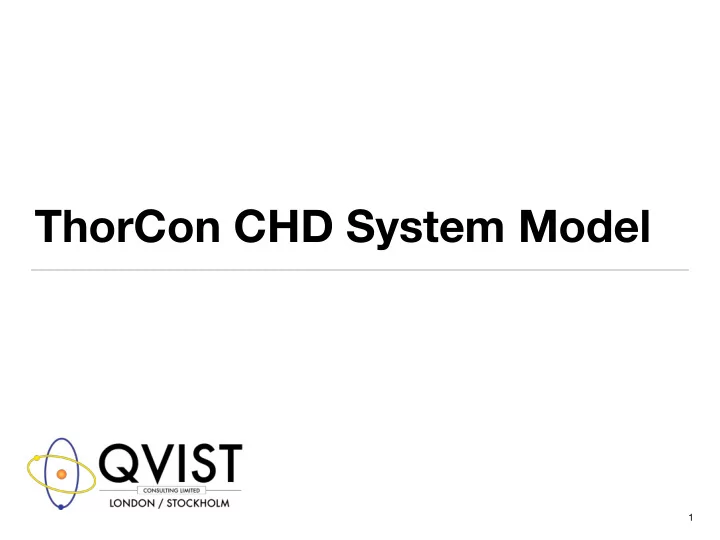

ThorCon CHD System Model � 1
Team introduction Dr Staffan Qvist, PhD Nuc. Eng. UC Berkeley (13’) • Chair of IAEA reactor shutdown systems study • Inventor of ARC passive safety systems and lead core designer/developer for SEALER LFR, • Project manager for Nuc. Dev Projects Dr Carl Hellesen, PhD Nuc. Eng. Uppsala University (10’) • Lead developer of CHD code • Physicist and lecturer at Uppsala University • Systems code development expert Dr Ryan Bergmann, PhD Nuc. Eng. UC Berkeley (14’) • Lead developer of WARP GPU Monte-Carlo code • Physicist at Paul Scherrer Institute (PSI), Switzerland • Neutronics & Monte-Carlo Code Expert
CHD Code Introduction • CHD is a multi-channel point-kinetics based dynamic reactor simulation code • Conceptually similar to codes such as SAS4A/ SASSYS-1, THACOS, SSC-L and MAT5-DYN • Fully object oriented and is written entirely in Python, with numerical calculations done with the standard packages numpy and scipy. • Extremely flexible and customisable, allowing for rapid addition of complex components • Originally written for fast reactor analysis, now a fully capable MSR-simulation code further developed specifically to model the ThorCon plant • Validated/benchmarked against the available MSRE and EBR-II experimental results, as well as code-to-code benchmarking including the large ESFR benchmark. � 3
CHD Code ThorCon Model � 4
CHD Code ThorCon Model Surrounding structures Gas Header tank M 1 ch 1 M N ch N Core steam cycle PHX SHX � 5
ThorCon Core Representation • The core is modelled using 1/12th symmetry, with each gap section between each log modelled as a separate channel and all the holes in each distinct log are also treated as separate channels. • There are 41 separate parallel channels in the core. • Delayed neutron precursors are tracked throughout the primary loop. All core channels transport and produce precursors separately. • Decay heat is modelled using a 23-group structure. � 6
ThorCon Core Representation Serpent model used to Example of CHD output calculate reactivity (temperature distribution feedback coefficients during transient) � 7
Transient Simulation Results � 8
Transient #1 - Reactivity Insertion • 400 pcm reactivity inserted during 10 s – Power spikes at 210% – Settles at 115% after 40 s • No separate channel or graphite log above 850 C � 9
Transient #2 - Flow&Power Ramp (1/2) All salt loops and feed water flow • reduced by 50% and ramped up again by 50% – 300 s ramp time(10%/min) Power can be controlled using only • flow rates in loops – No control rods required for load following In this example, all loops ramped • uniformly – Control algorithms to adjust flows individually for constant steam temperatures will be developd using ThorCon model � 10
Transient #2 - Flow&Power Ramp (2/2) All salt loops and feed water flow • reduced by 50% and ramped up PHX again by 50% – 300 s ramp time(10%/min) Power can be controlled using only • flow rates in loops SHX – No control rods required for load following In this example, all loops ramped • SG uniformly – Control algorithms to adjust flows individually for constant steam temperatures will be developd SG & SRH using ThorCon model � 11
Transient #3 - Fukushima-Eq. Scenario • At time of earthquake, a controlled drain is initiated SCRAM shuts down the fission power – • Power and cooling available for a limited time after SCRAM AC power, batteries, diesels, … – • At drain time, the reactor is put into a safe state with salt in drain tank Salt temperatures max at 750 C – � 12
Transient #4 - Instant Station Blackout • At time of earthquake, a drain is initiated SCRAM shuts down the fission power – • All power and cooling lost directly after SCRAM Worse than Fukushima – Core is initially cooled by natural – convection • At drain time, the reactor is put into a safe state with salt in drain tank Salt temperatures max at 850 C – � 13
Transient #5 - Instant Unprotected Station Blackout • All safety systems fail No shutdown rods – No backup power – No cooling – Much worse than Fukushima – Fission power shut down from • negative feedbacks Passive natural circulation provides – initial cooling At drain time, the reactor is put • into a safe state with salt in drain tank Salt temperatures max at 1000 C – 0.25% of steel creep lifetime used up – � 14
Recommend
More recommend